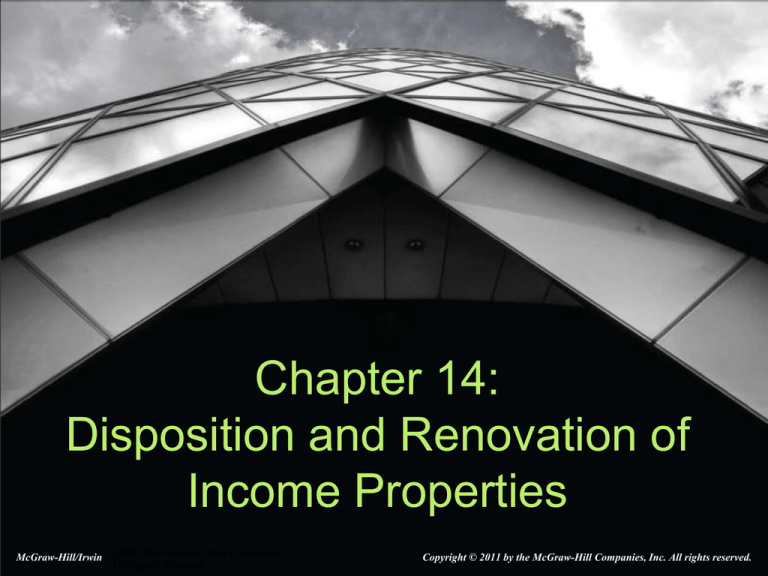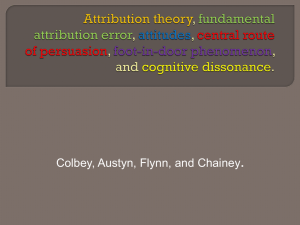
Chapter 14:
Disposition and Renovation of
Income Properties
McGraw-Hill/Irwin ©2008 The McGraw-Hill Companies,
All Rights Reserved
Copyright © 2011 by the McGraw-Hill Companies, Inc. All rights reserved.
Disposition Decisions
Disposition Consideration
– Changes in expectations over an anticipated
holding period
Market rent problems
Tax law changes
– Equity build-up
There is an opportunity cost of not selling the
property. Over time, the equity that is built up
represents substantial buying power that could be
redeployed to buy additional properties.
Reduced interest payments and lower tax
deduction
14-2
Disposition Decisions
Decision Rule: Property Disposition
– What can the investor net if the property is
sold today?
– What is the future expected performance of
the property for the current investor if not
sold?
– Should the property be sold and the funds
invested in another property?
14-3
Disposition Decisions
Expected cash flows are adjusted for
current expectations
– New rental income growth rate assumptions.
– Original cost and depreciation stay in place.
– Tax rates change to reflect current laws.
– Mortgage and interest stay the same.
– What is the expected future sale price of the
property?
14-4
Disposition Decisions
If the investor will net $100,000 after all
taxes and expenses if the property is sold
today, can it be invested and earn a
greater return than if the property is not
sold?
Basically, it’s a matter of comparing future
streams of cash flow.
14-5
Disposition Decisions
The future expected net cash flows for a
three-year holding period are
– ATCF0 = ($100,000)
– ATCF1 = $10,000
– ATCF2 = $11,000
– ATCF3 = $12,000
– ATCF3(sale) = $103,000
– Compute IRR = 11.82%
14-6
Disposition Decisions
The ATIRR = 11.82% is what the investor
gives up by selling the property and taking
$100,000 today.
Is there an investment of comparable risk
that can earn a greater ATIRR?
– If yes, the sale is justified.
– If not, property should be held onto.
14-7
Disposition Decisions
Return to a New Investor
– New investor has a new adjusted basis in the
property.
– New investor depreciates the property based on
current tax law.
– The point is that changes in tax law can influence sale
decisions as it may favor new investors more or less
favorably.
What can a new investor earn given the
changes?
– Compute an ATIRR for the new investor.
14-8
Disposition Decisions
Marginal Rate of Return
– Property Disposition:
Evaluate disposition for a one-year holding period.
Repeat the evaluation for subsequent one-year holding
periods.
This generates a series of marginal returns based on oneyear holding periods.
ATCFS (t 1) ATCFO(t 1) ATCFS (t )
MRR
ATCFS (t )
14-9
Disposition Decisions
Marginal Rate of Return
– Disposition Rule:
Sell when MRR falls below assumed reinvestment
rate for funds from property sale
Optimal holding period
– Reinvestment Rate:
Could be constant or could change with overall
market conditions
Should reflect market rates and return on
alternative investments
14-10
Exhibit 14-9
Holding Period Analysis
14-11
Exhibit 14-10
Holding Period Analysis
14-12
Disposition Decisions
Refinancing as an Alternative
– Increase the current LTV ratio by refinancing
Provides additional funds to invest
– Incremental cost of refinancing
What are the additional funds obtained by
refinancing?
What are the additional cash outflows?
Solve for i: can this be earned or borrowed funds?
– Diversification benefits from reinvesting loan
proceeds
14-13
Disposition Decisions
Tax Deferral Strategies upon Disposition
– Installment Sale
In essence, a form of “seller financing”
Profit ratio
Contract price
14-14
Tax Deferral Strategies
Tax Deferral Strategies upon Disposition
– Like kind or tax free exchange
Also known as a “1031 exchange”. It is so named
because it is a creation of Section 1031 of the
United States tax code.
Specific time frames must be established
Safe harbor rules
∙ Qualified escrow accounts, trusts, and intermediaries
Balancing equities
∙ Unrecognized gain = realized gain – boot
Reverse exchanges are also possible
14-15
Disposition Decisions
Renovation as an alternative
– What are economic trends?
Is property improvement justified?
∙ Enlarged or quality upgraded
Should it be converted?
∙ Alternative use to reflect market changes
– What is the renovation cost?
Does it require additional equity?
What are available financing sources?
14-16
Disposition Decisions
Renovation as an alternative
– Calculate the incremental change in the
expected future operating cash flows.
– Calculate the incremental change in the future
expected selling price of the property.
– Determine the IRR on the additional equity
investment.
– Compare the IRR to alternative equivalent risk
investments.
14-17
Disposition Decisions
Additional Considerations
– Combined renovation and refinancing
– Portfolio balancing
– Rehabilitation Investment Tax Credits
Dollar for dollar reduction in taxes
10% credit if placed into service before 1936, 20%
if certified historic structure
– Low-Income Housing Tax Credit
Creation of Tax Reform Act of 1986
14-18





